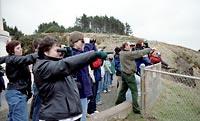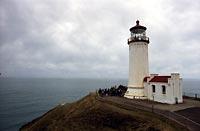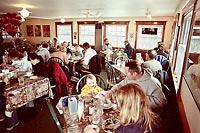Thar she blows! It's whale-watching time at the coast

ILWACO, Pacific County — Here they come, majestic masters of one of the longest migrations on Earth: the mighty gray whale.
Eschrichtius robustus is one of the most celebrated visitors to our shores, especially on its northbound migration, when the great grays sometimes come close enough to the Oregon and Washington coasts to count their barnacles, even from shore. The gray whale migration is just now getting under way in earnest. And Sunny Major and her cohorts are ready for them.
Major, of Florence, Ore., put her love for gray whales to work along with about 50 other whale-watching volunteers. They recently took part in a training session sponsored by Oregon State Parks to learn how to help whale-watchers hoping to catch sight of grays on the move.
Volunteers looked off to the blue distance, practicing spotting techniques at the North Head Lighthouse, where the trees are flagged back by wind so stiff, light keepers used to crawl to their station on their knees.
A gray whale's spout can shoot 25 feet in the air, and is best seen with the naked eye, with the sun at your back. From there, it's a matter of dialing the animal in on binoculars or a spotting scope for a better look.
"Like a cross between a ballerina and a freight train," was how volunteer Bob Anderson of Pacific City, Ore., described the motion of a swimming gray.
The volunteers will be at 28 whale-watching spots on and near the Oregon coast during Whale Watch Week, starting Saturday and continuing through April 1, a peak migration time. In Washington, volunteers will staff whale-watching locations at Cape Disappointment State Park's Lewis and Clark Interpretive Center and the North Head Light, both in Ilwaco.
To Major, learning about the biology of gray whales was a labor of love. With an orca tattoo on her shoulder, her commitment to the whales was more than skin deep.
She thrilled at stories told by instructors of gray-whale mothers presenting their babies boat-side in Baja birthing lagoons to tourists for petting. "We hunted them nearly to extinction, and yet they have the capacity to forgive," Major said. "How many people can do that?"
When and where
to watch
Whale-watching is possible up and down the Washington coast, from the flat sands of the Long Beach Peninsula to the craggy sea stacks of Neah Bay.
Reaching 45 feet in length (longer than a bus) and weighing up to 35 tons, the massive mammals migrate from the Bering Sea to Baja California, Mexico, and back, a journey of some 10,000 miles. No mammal migrates farther.
Southbound migrating whales glide down the coast from December through early February, on the way to their breeding and calving grounds.
Northbound whales cruise by in late February through early June, on their way to the Bering Sea. But some whales stick around, instead of migrating. Whale researchers have tracked dozens of these so-called resident whales for years, spotting them by their unique barnacle markings and scars, and even giving them pet names.
Some towns throw themselves into the migration more than others. On the Long Beach Peninsula and surroundings, the whale has left its fluke print on land as well as on sea.
The skeleton of a juvenile whale marks a boardwalk trail in downtown Long Beach. It's a good clue that a stay on the peninsula offers a rare combination on the Washington coast: the chance to observe a bit of wild nature, amid fine dining and a wide choice of places to stay, many far above the rugged.
Beds and breakfast
Consider the Moby Dick Hotel and Oyster Farm in Nahcotta, right on Willapa Bay, where they have taken the whale theme tastefully to heart.
It starts with Melville the cat, who greets visitors as they arrive in the hotel's sitting room, where a fire is a welcome companion.
From the whale vertebrae out on the patio to a whale rib over a door, the whale-themed stained glass in the dining room and a triptych over the bar of the white whale evading the hunters from "Moby Dick," it's hard to miss the theme.
The bookshelves are replete with fine literature, including, of course, many copies of "Moby Dick," even a Spanish version for children.
All of this goes down particularly easily after dinner in the house restaurant, where the chef serves up seasonal delicacies bolstered by service from a full bar and a comprehensive, moderately priced wine list.
Oysters are a house specialty — Keith Stavrum sees to that. "The oysters you had at breakfast, I picked," he says. And boast he should, for they are perfect, tender, gently sautéed with a bit of butter, parsley and lemon, enhancing the briny taste of the bay.
Stavrum is the manager of the hotel's oyster beds, but to say it like that is a bit like saying Mozart liked music. For Stavrum, the oyster is a high calling, a work of art always in progress.
Sunk to the ankle in mud at low tide, he patrols the flats out back of the Moby with his ebullient Rottweiler-shepherd mix, Hoss, much given to galloping over the mud with a splattering joy.
"Look at that Christmas tree!" says Stavrum, holding up a thickly branched cluster of oysters, growing fat on the rich tide flats.
To the inexperienced eye, they may not look appetizing in their jackets of muddy goo. But Stavrum sees what counts: rings in the shells that indicate robust growth. And he can read this mud like a book, finding clams amid the oysters, too, ready for the steamer.
"Isn't this kind of a nice stroll?" he says, taking in the view of the verdant hump of Long Island across the shimmering expanse of the bay.
His understatement is typical for the Moby, an unpretentious getaway nestled on nearly seven acres of gardens and trails.
Built in 1929, the hotel has a vintage, Bohemian appeal, with just eight guest rooms. Each is different, one with a deep soaking tub, and many with views of the bay, the garden out front with its wine-bottle borders or both.
Dinner, sauna and Hoss
From here it's just minutes to the Pacific beaches for razor clamming, birding or whale-watching. And if you can pry yourself away from the Moby's fine dining, the Peninsula is replete with good food.
At the 42nd Street Cafe, wedged between a gas station and a car repair shop in Seaview, the diner has no clue from the street of the gourmet delights inside.
Locally caught fresh sturgeon, razor clams fresh from the beach, steak spiked with blue-cheese butter, topped with a crunchy golden fleece of fried onions — who could ask for more?
After you eat all that, they will be waiting for you back at the Moby, with a sauna reserved for the hour of your choice, for your private use alone, in a cedar-lined spa overlooking the bay.
As you walk, pink and steaming, back to the hotel, the scent of wood smoke from Stavrum's wood-fired oven in the oyster shack just might draw you in, for a capper of oysters on the half shell, and a beer.
And if you didn't bring your dog — they are welcome at the Moby — they've got that covered here, too. For there's Hoss, happily tired from oyster patrol, ready to curl up at your feet by the fire.
It's a great way to unwind and think over the day, from the slow wing beats of herons over the oyster flats, to the majestic grays lumbering slowly up the coast.
Lynda V. Mapes: 206-464-2736 or lmapes@seattletimes.com






Whale season
Spring Whale Watch Week begins Saturday and continues through April 1 on the Northwest coast. Trained volunteers with the "Whale Watching Spoken Here" organization will be at 28 locations from Ilwaco, Wash., south to Crescent City, Calif., from 10 a.m. to 1 p.m. daily to help visitors spot gray whales and learn about them. (Last March during Whale Watch Week, volunteers at Ilwaco's Cape Disappointment State Park helped 879 visitors spot 203 whales.) For a complete list of manned whale-watching sites, and for information on boat charters, see www.whalespoken.org.
For more whale-watching information, call the Depoe Bay Whale Center in Oregon at 541-765-3304.
Whale-watching tips
Bring binoculars, and wear warm, weather-appropriate clothing. Morning light (with the sun at your back) is often helpful to spot whale blows. Look first with your naked eye, then focus more closely with binoculars. Calmer days are better whale-watching days.
Lodging
The Moby Dick, 25814 Sandridge Road in Nahcotta, is a small hotel, so be sure to make reservations well in advance, particularly for popular times, such as clamming weekends. The entire Long Beach Peninsula is so packed on a clam weekend, you'll want reservations for dinner as well, whether at the Moby or elsewhere.
Off-season rates through April: $85-$125 per night. For tours of the rooms, menus and more, see www.mobydickhotel.com. To call the restaurant: 360-665-4690. The hotel: 360-665-4543.
The hotel will require half your room fee up front as a deposit, and maintains a strict cancellation policy, so make your plans carefully. A three-course breakfast is included in the rate, and dogs are welcome.
No TVs or phones in the rooms, but there is a TV and VCR with a good stock of videos in the common room downstairs. A house phone is available for credit-card calls.
Dining
The Oyster Shack at Moby Dick Hotel, hosted by Keith Stavrum, serves up oyster po' boys, fried oysters and more, all cooked on the wood-fired stove. Stavrum also sells fresh oysters from the farm by the bag. The shack is available for private parties and catering. Open Friday, Saturday and Sunday from 11 a.m.-2 p.m. 360-665-4543.
The 42nd Street Cafe is at 4201 Pacific Way in Seaview. For reservations, call 360-642-2323. The cafe serves breakfast, lunch and dinner and has an outstanding wine list and local seafood. Service is deft and friendly. On Sundays, October through Mother's Day, owner/chef Cheri Walker plays the harp from 6-8 p.m. in the dining room. Menus are online at www.42ndstreetcafe.com.
More information
800-451-2542 or www.funbeach.com.
Whales elsewhere
A small group of gray whales typically spends early March through May in the area of Saratoga Passage, between Whidbey and Camano islands. Whales can be viewed from shore, or join a commercial whale-watching cruise from Everett, weekends through April 15, $12.50-$34. Contact Mosquito Fleet, 800-888-2535 or www.whalewatching.com.
For information about orca whale- watching, see the Web site for the Whale Museum in Friday Harbor: www.whalemuseum!.org